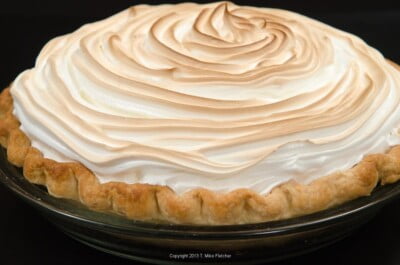 When I first thought about blogging about a Lemon Meringue Pie I thought it would be an easy blog since everybody knows about Lemon Meringue Pie.
When I first thought about blogging about a Lemon Meringue Pie I thought it would be an easy blog since everybody knows about Lemon Meringue Pie.
That might have been one of my biggest misconceptions in pastry. As I began researching, I found no one agreed on a number of details. Among the problems were the meringue separating from the shell after it was baked, the pie getting watery after cutting, and the meringue “weeping”.
Most recipes recommended putting the meringue on while the filing was hot, making sure it was attached to the crust. It seems everybody agreed on that. Finishing it in a 350°F oven for 10 to 12 minutes to brown it was also pretty much the norm. So that was test #1. The results were less than desirable. The meringue separated and the tart got very watery after refrigerating it. The soggy crust was a real turn off!
A lot of people quoted Alton Brown who can dispense some really bad information. His theory that putting the meringue on the filling when it was hot would partially bake the meringue. Now there is a misstatement for the ages! The first thing to realize, is that no matter what you do meringue does not bake. It either stays soft as in the topping for Baked Alaska and Lemon Meringue Pie or it is dried out in the oven as in a Pavlova shell or meringue cookies. The top may brown but it never bakes through.
The sugar allocated to the meringue in most recipes was between ⅓ to ½ cup to 4 egg whites. In my second test, I used ½ cup sugar (100 grams or 3 ½ ounces) to 4 egg whites. However, this time I decided to put them on a chilled filling. Big mistake! I covered the filled crust with film and refrigerated until it was cold. However, it condensed and no amount of patting it with paper towels dried it enough to keep the meringue tight to the filling.
So at this point I started researching some more when I came across an answer to the question, “How do you keep meringue from pulling away from the sides of a pie after it is baked? The person answering the question was Takamo – no kind of address so that is all I can tell you. His answer was directly opposed to most of the information on the internet or in cookbooks, but it works. His reasoning is spot on and it was wonderful to find something that I had been thinking about.
Basically, he agreed with attaching the meringue to the side of the crust, particularly the inside of the crust on top. However, he explains that the meringue should be put on top of a room temperature filling. Not chilled, not hot, just room temperature. His reasoning is thus: “Hot filling is what causes the sugar in the meringue to liquefy when condensation occurs due to the heat. The filling must be cooled first.
Then, the meringue, when made should incorporate cream of tarter which is often left out during its preparation. This stabilizes the mixture and prevents the egg whites from separating. Also, excessive whipping can cause the meringue to separate, as does an inaccurate amount of sugar added to the egg whites. Here is a recipe for meringue: Rule of thumb: one cup of sugar for every 3 large egg whites. (for medium sized eggs, use four eggs and for jumbo sized eggs, add ¼ cup of sugar) Rule of thumb,: ¼ teaspoon of Cream of Tartar for every 3 egg whites. (for meringue only) Egg size in this case doesnt matter. 1 teaspoon of vanilla for every cup of sugar.
The whipping time varies. Room temp, size of eggs and speed of mixer are dependent on how fast the eggs whip. Always start on a low speed until the eggs start to foam. Then finish on medium speed. High speed on the mixer causes the egg whites to separate and the formation of the meringue can occur too quickly and control of the meringue is lost. The idea is to slowly incorporate air into the mixture, not breaking down the egg whites. The chemical properties of the sugar are what “cook” the egg whites. Not heat.
During the browning stage of the meringue, the oven will tend to cause the sugar to further absorb the moisture from the eggs and cause it to become “syrup-like” Low temps on the oven are the culprit. Pre-heat and set your oven to “broil” then place the pie on the shelf lowest to the heating source. With the door open, watch the pie brown. It only takes a minute or two to do so. If you have to, rotate the pie for even browning and quickly remove it. Allow it to cool to room temp before putting it in the fridge. In a professional kitchen, I some times use a propane torch to brown the tops, but it takes a skilled hand. Source: La vie du Boulanger, Marcel Neau cir;1984″
So I tested his version also – #3. I agree with much of what he says but disagree with his egg white/sugar ratio. The meringue is simply too heavy. One of the important standards of a good lemon meringue pie is that it be topped with billows of meringue. Three egg whites and 1 cup of sugar does not produce billows. I also found the sugar would not completely dissolve in the egg whites. I beat it for over 10 minutes on medium as Takamo suggested but a grittiness from the sugar was still there.
To sum up: First, It is important to cover the lemon filling with film after being made and poured into the shell. Then allow it to cool at room temperature. At this point and not before, the meringue is added.
Second, using 4 egg whites from size large eggs and 1cup of sugar (200 grams or 7 ounces) is a two to 1 ratio by volume producing the high meringue requisite to this pie. To insure the meringue does not pull away from the crust it is best to pipe it in a circular motion starting at the inside of the exposed crust. I piped several times building up the meringue for an attractive look. I know some recipes spoon the meringue onto the crust but I think that is leaving open the possibility of not attaching it to the crust all the way around.
Third – the final important point is to brown it under a preheated broiler. This prevents the sugar in the meringue from becoming too hot as it will in a lower temperature oven baked for a longer time.
Following these rules, the meringue will stay attached for days in the refrigerator with no weeping either on your part or the part of the meringue and without the filling becoming watery if it is kept for several days. Even after I left the pie in the refrigerator for four days the meringue did not separate nor did it “weep” which is also caused by slow browning of the crust. The filling did not become watery so the crust stayed crisp.
1 ¾ cups sifted cake flour (6 ⅓ ounces or 180 grams) ⅓ cup sifted all purpose flour (scant 1 ½ ounces or 40 grams) ¾ teaspoon salt 6 tablespoons butter, cut into pieces and frozen until hard (90 grams or 3 ounces) 3 tablespoons shortening (like Crisco) frozen and cut into pieces (45 grams or 1 ½ oz.) 2 tablespoons beaten egg 1 teaspoon lemon juice 5 tablespoons water, chilled and divided
Place both flours and the salt in the processor bowl. Pulse several times to mix. Place the butter evenly over the flour and pulse until the butter is in large pieces. Add the frozen shortening and continue to pulse until the shortenings are pea sized.
Combine the egg, lemon juice and water. Pour in a circle over the processor contents. Pulse until it forms clumps. Pour out onto a lightly floured work surface. Push the clumps together into a ball. Knead 4 or 5 times for form a dough. Pat into a circle about 1 inch thick. Wrap in film and refrigerate a minimum of 2 hours or overnight.
On a lightly floured surface, roll out to a circle approximately 13 inches. Place in the pie pan and fit into corners. Cut the overhang an even 1 inch all the way around. Tuck the crust under and flute the edges. To bake blind, freeze for 30 or more minutes until hard. Line with foil, and fill with beans. Bake for 20 minutes in the oven. Remove the beans by bringing the four corners of the foil together and lifting out. Return to the oven and bake for approximately 18 to 20 minutes until lightly browned and completely baked.
Lemon Filling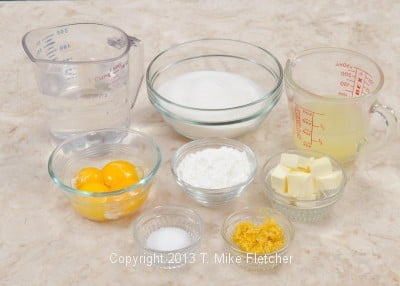 4 eggs, separated 1 ¼ cups water 1 ⅓ cups sugar (265 grams or 9 ⅓ ounces) ⅓ cup cornstarch (45 grams or 1 ½ ounces) ½ teaspoon salt 3 tablespoons butter, cut in small pieces (45 grams mor 1 12 ounces) ⅔ cup lemon juice 1 tablespoon grated lemon zest 1 fully baked 9″ pie shell
4 eggs, separated 1 ¼ cups water 1 ⅓ cups sugar (265 grams or 9 ⅓ ounces) ⅓ cup cornstarch (45 grams or 1 ½ ounces) ½ teaspoon salt 3 tablespoons butter, cut in small pieces (45 grams mor 1 12 ounces) ⅔ cup lemon juice 1 tablespoon grated lemon zest 1 fully baked 9″ pie shell
In a medium saucepan, whisk together the water, sugar, cornstarch and salt. 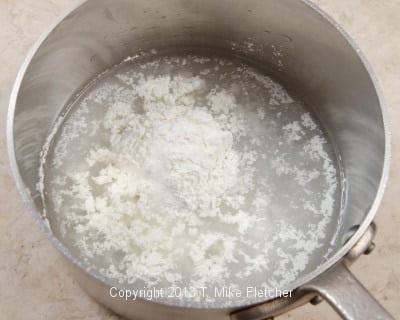 Place over medium heat and, whisking constantly, bring the mixture to a boil. Boil for one minutes. It will be very, very thick. Remove from the heat.
Place over medium heat and, whisking constantly, bring the mixture to a boil. Boil for one minutes. It will be very, very thick. Remove from the heat.
Whisk the yolks together and add several large spoonfuls of the hot mixture. 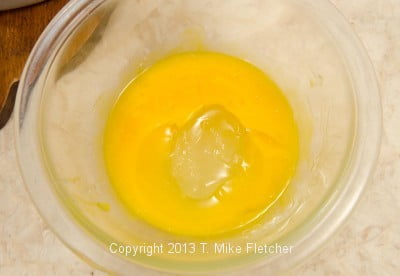 Whisk in.
Whisk in. 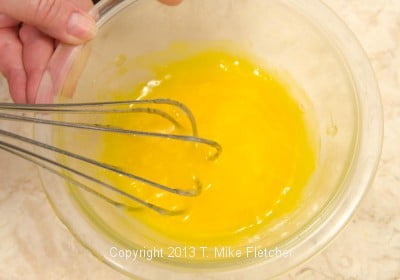 Repeat twice more.
Repeat twice more.
Pour back into the saucepan 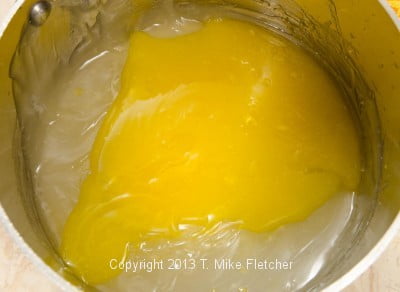 and whisk all together.
and whisk all together.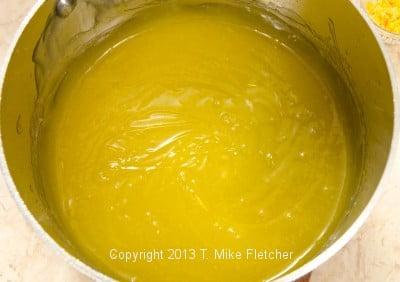 Place back on the heat and bring to a boil once more. Boil for one minute. Remove from the heat.
Place back on the heat and bring to a boil once more. Boil for one minute. Remove from the heat.
Submerge the butter under the sauce and let it sit for a few minutes to melt. 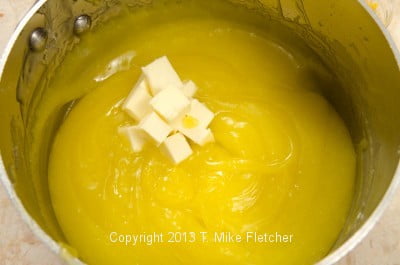 Add the lemon zest.
Add the lemon zest. 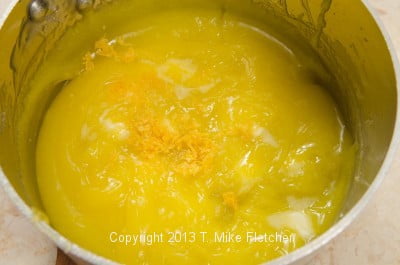 Lastly add the lemon juice.
Lastly add the lemon juice. 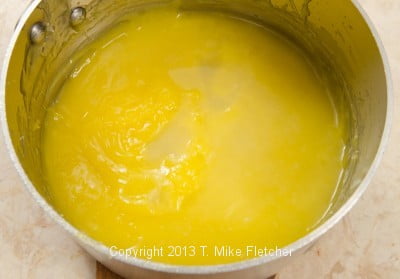 Whisk gently to combine all. Immediately pour it into the pie shell.
Whisk gently to combine all. Immediately pour it into the pie shell. 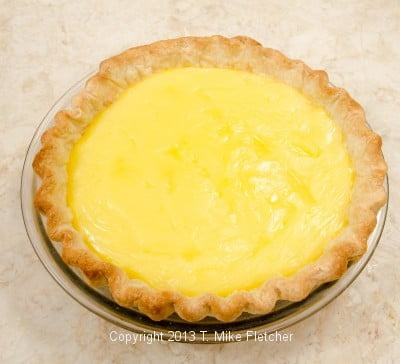
Meringue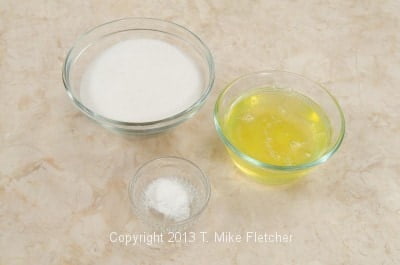 4 egg whites from above ½ teaspoon cream of tarter 1 cup sugar (200 grams or 7 ounces)
4 egg whites from above ½ teaspoon cream of tarter 1 cup sugar (200 grams or 7 ounces)
Place the egg whites and cream of tarter in a mixing bowl. 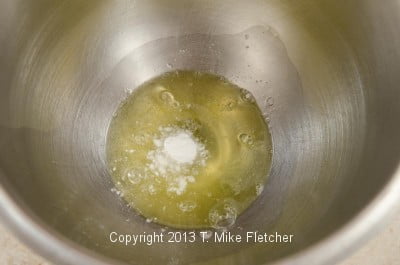 Beat until soft peaks begin to form.
Beat until soft peaks begin to form. 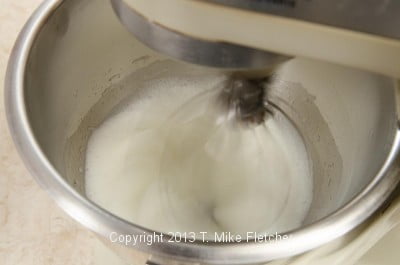 Gradually add the sugar.
Gradually add the sugar. 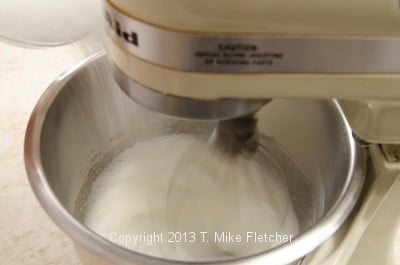 Beat to really stiff peaks.
Beat to really stiff peaks. 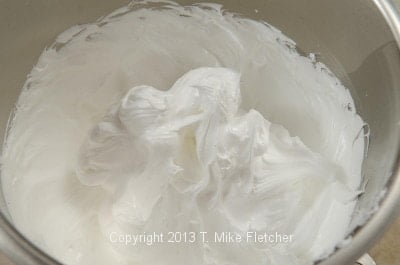
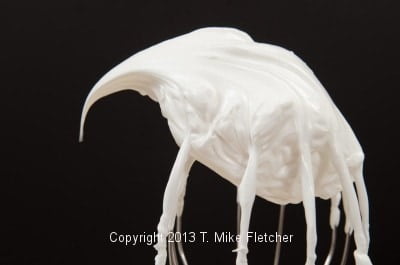 Place in a piping bag fitted with a large open star (#8 or 9 open star) and pipe the meringue onto the lemon filling starting at the inside edge of the crust.
Place in a piping bag fitted with a large open star (#8 or 9 open star) and pipe the meringue onto the lemon filling starting at the inside edge of the crust. 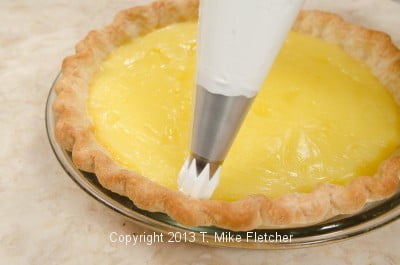 Make sure the meringue attaches to the pie crust all the way around.
Make sure the meringue attaches to the pie crust all the way around. 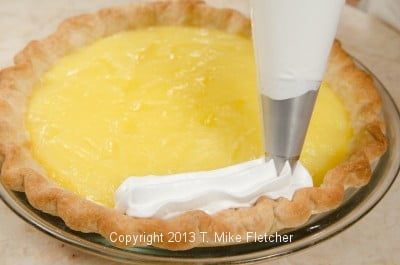
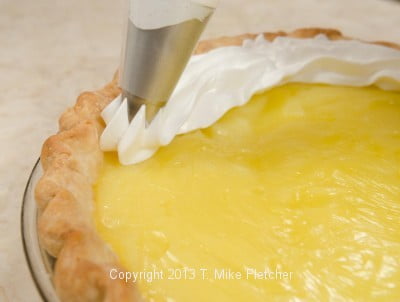 Then pipe in concentric circles towards the middle.
Then pipe in concentric circles towards the middle. 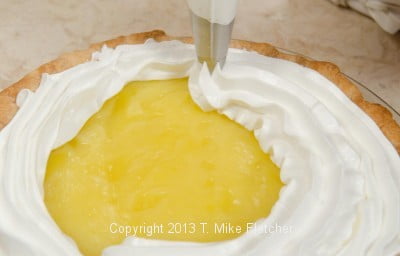
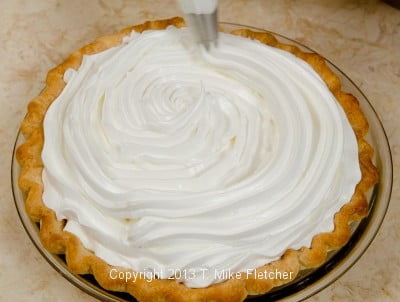 Pipe more meringue on top of the already piped meringue until it is all used.
Pipe more meringue on top of the already piped meringue until it is all used. 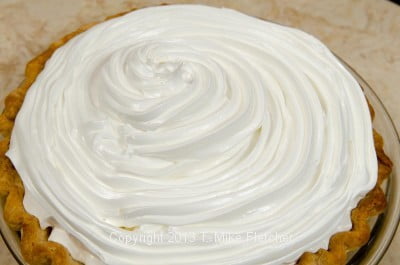 Alternately, just spoon it on and make swirls with the spoon making sure you are attaching it all the way around to the crust.
Alternately, just spoon it on and make swirls with the spoon making sure you are attaching it all the way around to the crust.
Place the pie on a rimmed baking sheet and into the oven for about 1 minute and 15 seconds or until lightly browned. Watch it carefully as the top most peaks of the crust will burn quickly. Cool completely before cutting. Store in the refrigerator.
Cool completely before cutting. Store in the refrigerator.
Tons of billowy meringue over a tart lemon filling and flaky pie crust. Take note of the meringue attached to the edge of the shell. Get the forks ready!!
Spoon the meringue onto the hot pie filling. If you are topping an unbaked pie filling, have it at room temperature (not cold) before you top it with the meringue. Spread the meringue to the crust edge to seal the filling in.

The whipping time varies. Room temp, size of eggs and speed of mixer are dependent on how fast the eggs whip. Always start on a low speed until the eggs start to foam. Then finish on medium speed. High speed on the mixer causes the egg whites to separate and the formation of the meringue can occur too quickly and control of the meringue is lost. The idea is to slowly incorporate air into the mixture, not breaking down the egg whites. The chemical properties of the sugar are what “cook” the egg whites. Not heat.
Second, using 4 egg whites from size large eggs and 1cup of sugar (200 grams or 7 ounces) is a two to 1 ratio by volume producing the high meringue requisite to this pie. To insure the meringue does not pull away from the crust it is best to pipe it in a circular motion starting at the inside of the exposed crust. I piped several times building up the meringue for an attractive look. I know some recipes spoon the meringue onto the crust but I think that is leaving open the possibility of not attaching it to the crust all the way around.
Then, the meringue, when made should incorporate cream of tarter which is often left out during its preparation. This stabilizes the mixture and prevents the egg whites from separating. Also, excessive whipping can cause the meringue to separate, as does an inaccurate amount of sugar added to the egg whites. Here is a recipe for meringue: Rule of thumb: one cup of sugar for every 3 large egg whites. (for medium sized eggs, use four eggs and for jumbo sized eggs, add ¼ cup of sugar) Rule of thumb,: ¼ teaspoon of Cream of Tartar for every 3 egg whites. (for meringue only) Egg size in this case doesnt matter. 1 teaspoon of vanilla for every cup of sugar.
Most recipes recommended putting the meringue on while the filing was hot, making sure it was attached to the crust. It seems everybody agreed on that. Finishing it in a 350°F oven for 10 to 12 minutes to brown it was also pretty much the norm. So that was test #1. The results were less than desirable. The meringue separated and the tart got very watery after refrigerating it. The soggy crust was a real turn off!
On a lightly floured surface, roll out to a circle approximately 13 inches. Place in the pie pan and fit into corners. Cut the overhang an even 1 inch all the way around. Tuck the crust under and flute the edges. To bake blind, freeze for 30 or more minutes until hard. Line with foil, and fill with beans. Bake for 20 minutes in the oven. Remove the beans by bringing the four corners of the foil together and lifting out. Return to the oven and bake for approximately 18 to 20 minutes until lightly browned and completely baked.
A: Meringues can be so problematic because they are foams made with egg whites, which are mostly water and particularly sensitive to heat.
Make sure you’re spreading your meringue over a hot — not cooled — pie filling. Otherwise, your meringue will bake on top, but the cooled pie filling won’t get hot enough to cook the meringue on its bottom in the short 15 to 20 minutes needed to bake a meringue.
Q: Can you tell me how to make a meringue that will stand up to humidity and heat? I can make beautiful meringues, but, as the day goes on, they collapse.
Mix 1 tablespoon cornstarch and 1 tablespoon sugar in a small saucepan. Gradually stir in 1/3 cup water to make a smooth, runny paste. Bring to a boil over medium heat, stirring briskly; then boil for 15 seconds. Remove from heat and cover. In a clean glass or metal bowl, beat 4 room-temperature large egg whites until foamy. Add 1/2 teaspoon vanilla and 1/4 teaspoon cream of tartar, and beat until soft peaks form. Gradually beat in 1/2 cup granulated or superfine sugar. Beat on high speed until the peaks are very stiff and glossy but not dry. Reduce the speed to very low and beat in the cornstarch paste a little at a time. When all of the paste is incorporated, increase the speed to medium and beat for 10 seconds. Spread over a hot pie filling and bake as directed.
Sugar helps to stabilize a meringue and keep it firm, and starch helps even further. Adding starch to a meringue can be accomplished two ways: by using powdered sugar to sweeten instead of granulated, as powdered contains cornstarch; or by adding cornstarch to the meringue recipe. A cornstarch meringue recipe is often called “no fail” because the starch helps to guarantee its success.
Meringue tips for a No Weep Meringue Topping – Best Old Fashioned Southern Cooks
FAQ
Why must we add meringue onto a pie while the filling is still hot?
Do you refrigerate pies with meringue?
How do you keep a meringue pie from weeping?
How do you keep meringue from sliding off a pie?
